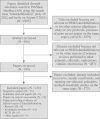Evidence-based position paper on Physical and Rehabilitation Medicine (PRM) professional practice on telerehabilitation. The European PRM position (UEMS PRM Section)
- PMID: 38477069
- PMCID: PMC11135123
- DOI: 10.23736/S1973-9087.24.08396-5
Evidence-based position paper on Physical and Rehabilitation Medicine (PRM) professional practice on telerehabilitation. The European PRM position (UEMS PRM Section)
Abstract
Introduction: The evidence on the utility and effectiveness of rehabilitation interventions delivered via telerehabilitation is growing rapidly. Telerehabilitation is expected to have a key role in rehabilitation in the future.
Aim: The aim of this evidence-based position paper (EBPP) is to improve PRM physicians' professional practice in telerehabilitation to be delivered to improve functioning and to reduce activity limitations and/or participation restrictions in individuals with a variety of disabling health conditions.
Methods: To produce recommendations for PRM physicians on telerehabilitation, a systematic review of the literature and a consensus procedure by means of a Delphi process have been performed involving the delegates of all European countries represented in the UEMS PRM Section.
Results: The systematic literature review is reported together with the 32 recommendations resulting from the Delphi procedure.
Conclusions: It is recommended that PRM physicians deliver rehabilitation services remotely, via digital means or using communication technologies to eligible individuals, whenever required and feasible in a variety of health conditions in favor of the patient and his/her family, based on evidence of effectiveness and in compliance with relevant regulations. This EBPP represents the official position of the European Union through the UEMS PRM Section and designates the professional role of PRM physicians in telerehabilitation.
Conflict of interest statement
References
-
- World Health Organization. WHO Global Observatory for eHealth. Telemedicine: opportunities and developments in Member States: report on the second global survey on eHealth; 2010 [Internet]. Available from: https://apps.who.int/iris/handle/10665/44497 [cited 2024, Jan 30].
-
- Alexander M. Chapter 1- Introduction. In: Alexander M. Telerehabilitation Principles and Practice. Elsevier, 2022.
-
- World Health Organization. Regional Office for Europe. From innovation to implementation: eHealth in the WHO European Region; 2016 [Internet]. Available from: https://apps.who.int/iris/handle/10665/326317 [cited 2024, Jan 30].
-
- World Health Organization. WHO guideline: recommendations on digital interventions for health system strengthening; 2019 [Internet]. Available from: https://apps.who.int/iris/handle/10665/311941 [cited 2024, Jan 30]. - PubMed
-
- World Health Organization. Regional Office for the Western Pacific. Implementing telemedicine services during COVID-19: guiding principles and considerations for a stepwise approach; 2020 [Internet]. Available from: https://apps.who.int/iris/handle/10665/336862 [cited 2024, Jan 30].
Publication types
MeSH terms
LinkOut - more resources
Full Text Sources


